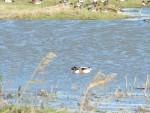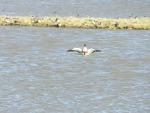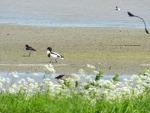 The Shelduck is a large-sized species of duck that can be easily identified due to it's distinctive appearance. Their bodies are mainly white in color with an orange chest band and black wings and although their heads do look black, they are in fact green in color.
The Shelduck is a large-sized species of duck that can be easily identified due to it's distinctive appearance. Their bodies are mainly white in color with an orange chest band and black wings and although their heads do look black, they are in fact green in color.
One of the most distinctive features of the Shelduck are their pinkish coloured legs, but it is their bills that make them incredibly easy to identify due to their bright red colouration. The bill of the male Shelduck also a bump at the base making it easier than numerous other water bird species to distinguish between the sexes.

Although Shelducks can be seen around the British coasts all year round, their population numbers swell in the winter months to more than 80,000 with the arrival of migrants from colder regions in Northern Europe. Some individuals are even known to winter as far south as Northern Africa depending on the region that they inhabit throughout the rest of the year.


